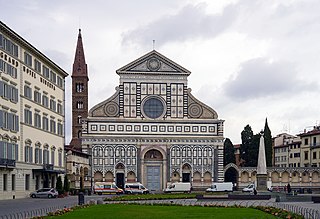
Santa Maria Novella is a church in Florence, Italy, situated opposite, and lending its name to, the city's main railway station. Chronologically, it is the first great basilica in Florence, and is the city's principal Dominican church.
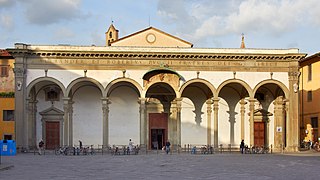
The Basilica della Santissima Annunziata is a Renaissance-style, Catholic minor basilica in Florence, region of Tuscany, Italy. This is considered the mother church of the Servite Order. It is located at the northeastern side of the Piazza Santissima Annunziata near the city center.

Pinturicchio, or Pintoricchio, also known as Benetto di Biagio or Sordicchio, was an Italian painter during the Renaissance. He acquired his nickname because of his small stature and he used it to sign some of his artworks that were created during the fifteenth and sixteenth centuries.
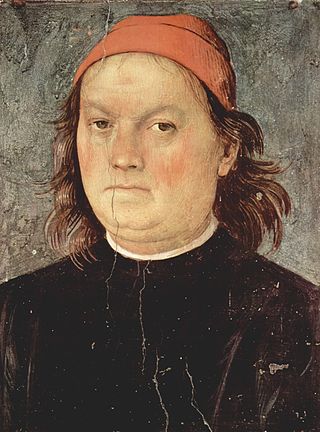
Pietro Perugino, an Italian Renaissance painter of the Umbrian school, developed some of the qualities that found classic expression in the High Renaissance. Raphael became his most famous pupil.

Cosimo Rosselli was an Italian painter of the Quattrocento, active mainly in his birthplace of Florence, but also in Pisa earlier in his career and in 1481–82 in the Sistine Chapel in Rome, where he painted some of the large frescoes on the side walls.
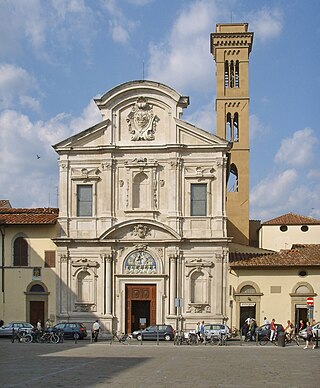
The chiesa di San Salvatore di Ognissanti, or more simply chiesa di Ognissanti, is a Franciscan church located on the piazza of the same name in central Florence, region of Tuscany, Italy. Founded by the lay order of the Umiliati, the church was dedicated to all the saints and martyrs, known and unknown.
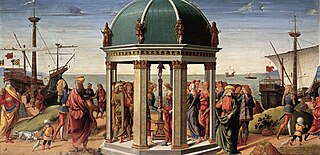
Biagio d’Antonio Tucci was an Italian Renaissance painter active in Florence, Faenza and Rome.
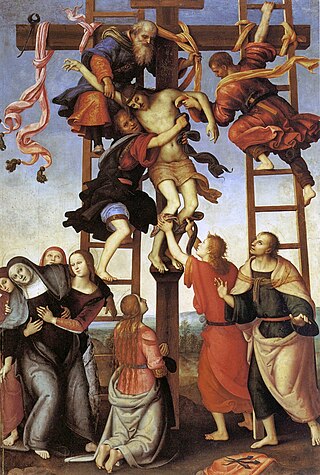
The Annunziata Polyptych is a painting cycle started by Filippino Lippi and finished by Pietro Perugino, whose central panel is now divided between the Galleria dell'Accademia and the Basilica dell'Annunziata, both in Florence, Italy. The polyptych had other six panels, which are housed in the Lindenau-Museum of Altenburg, the Metropolitan Museum of New York City, the Galleria Nazionale d'Arte Antica in Rome and in a private collection in South Africa.

Pietà is a painting by the Italian Renaissance artist Pietro Perugino, executed around 1483-1493, and housed in the Uffizi Gallery, Florence.
Sant'Ilario is an 18th-century, Baroque style, Roman Catholic church in the Cremona region of Lombardy, Italy. It is also known as the Oratory of San Girolamo.
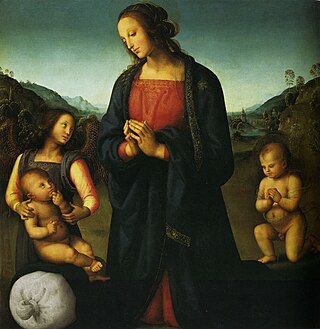
Madonna del Sacco is an oil on panel painting by Perugino, dating to around 1495–1500. It shows the Madonna and Child with the infant John the Baptist and an angel. It is now in the Galleria Palatina in Florence.

The Sant'Agostino Altarpiece is a painting by Perugino, produced in two stages between around 1502 and 1512 and then around 1513 to 1523. The altarpiece's 28, 29 or 30 panels were split up during the Napoleonic suppression of religious houses - most of its panels are now in the Galleria Nazionale dell'Umbria in Perugia. It is notable as the painter's last masterwork before he moved into his late phase producing more provincial commissions.

Madonna della Consolazione is an oil on panel painting by Perugino, datable ca. around 1496–1498. The work, completed in April 1498, was carried out in the Sala delle Udienze of the Collegio del Cambio. Since c. 1820 it is preserved in the National Gallery of Umbria in Perugia.

Mary Magdalene is an oil on panel painting of Mary Magdalene, dating to around 1500 and now in the Galleria Palatina in Florence - it has featured in its inventory since 1641. It is now attributed to Perugino. It is modelled on his wife Chiara Fancelli, who also modelled for several of his Madonnas. It is comparable to his Madonna and Child with St John the Baptist and St Catherine of Alexandria (Louvre), of similar date and with a similar dark background.
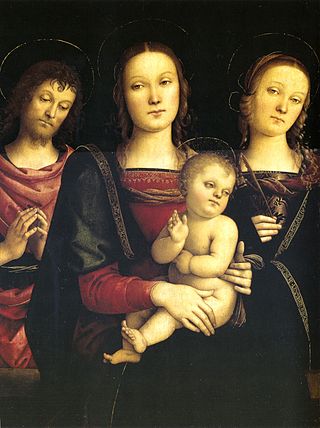
Madonna and Child with St John the Baptist and St Catherine of Alexandria is a c.1495 oil on panel painting by Perugino of the Madonna and Child with John the Baptist and Catherine of Alexandria. It is now in the Louvre in Paris.

Madonna and Child with the Infant John the Baptist is an oil on oak panel painting by Perugino, dating to around 1497 and now in the Städel Museum in Frankfurt-am-Main

The Monteripido Altarpiece is a double-sided altarpiece by Perugino, completed in 1502 for San Francesco al Monte church in Monteripido near Perugia. It is now in the Galleria Nazionale dell'Umbria in Perugia.

Madonna and Child with St Herculanus and St Constantius or Madonna of the Kitchen is a 1515 painting by Perugino, now in the Galleria Nazionale dell'Umbria in Perugia. Its title refers to the fact that it once hung in the former kitchen of the Palazzo dei Priori in Perugia. The two accompanying saints are Herculanus and Constantius, both local saints to Perugia.
Madonna and Child with St Peter and St Paul is a c.1515 painting by Perugino or his studio, held in the Collegiata dei santi San Pietro e Paolo in Monteleone d'Orvieto. It shows the Madonna and Child between St Peter and Paul of Tarsus, with a semi-circular cymatium showing the Resurrection.
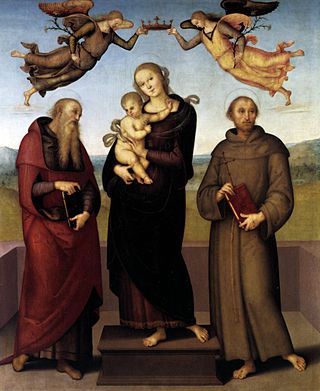
The Madonna of Loreto is a c.1507 oil on panel painting by Perugino, now in the National Gallery, London, which bought it in 1879. It shows the Madonna and Child flanked by Jerome (left) and Francis of Assisi (right). Two angels hover over Mary's head holding a crown. It reuses the low parapet from Madonna and Child with St Rose and St Catherine (1492) and probably also involved the master's studio assistants.


















